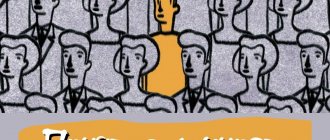Social status of an individual This is the position of a person in society, characterized by functions, rights and responsibilities.
We all perform certain functions in different areas of our lives. The status of a doctor is significant from the position of the patient, the head of the hospital, etc. Responsibilities exist to ensure that a person properly performs his social functions. The social role cannot completely determine the model of behavior, since its implementation is also closely related to the character of the individual.
Concept of personality
From a sociological point of view, a personality is an individual who, during socialization, acquires a specific set of socially significant qualities, properties, knowledge, skills and abilities. As a result of inclusion in social relations and connections, he becomes a responsible subject of volitional activity. According to psychologists, personality is an integral set of various traits of biogenic and sociogenic origin, which is formed during life and affects human behavior and activity. In both cases, the social role and status of the individual play an important role in the formation and self-realization of the individual.
The basis for the formation are four groups of phenomena: the biological characteristics of the human body and its innate experience, the results of learning, the experience of social life and interaction with other people, the results of self-esteem, reflection and self-awareness. In the personality structure, groups of characteristics can be distinguished that influence all human behavior.
These include such psychological traits as abilities, motivation, volitional qualities, social attitudes and stereotypes, character, orientation, emotions, temperament. Personality also includes a set of social characteristics, such as social statuses and roles, a system of dispositions and various role expectations, a complex of knowledge, values and beliefs, interests and worldview. The process of crystallization of personality traits often occurs under the influence of the external and internal environment and proceeds uniquely, creating a unique integrity.
Roles in society
A person’s social status will help to understand how this or that object will behave. We constantly find examples and confirmation of this. Expectations in the behavior and appearance of an individual depending on his membership in a certain class are called social role.
Thus, the status of a parent obliges him to be strict but fair to his child, to bear responsibility for him, to teach, to give advice, to prompt, to help in difficult situations. The status of a son or daughter is, on the contrary, a certain subordination to parents, legal and material dependence on them.
But, despite some patterns of behavior, every person has a choice of what to do. Examples of social status and its use by an individual do not fit one hundred percent into the proposed framework. There is only a scheme, a certain template, which each individual implements according to his abilities and ideas.
It often happens that it is difficult for one person to combine several social roles. For example, a woman’s first role is a mother, wife, and her second role is a successful businesswoman. Both roles require an investment of effort, time, and full dedication. A conflict arises.
An analysis of the social status of an individual and an example of his actions in life allow us to conclude that it reflects not only the internal position of a person, but also affects his appearance, manner of dressing and speaking.
Let's look at examples of social status and the standards associated with it in appearance. Thus, the director of a bank or the founder of a reputable company cannot appear at work in sweatpants or rubber boots. And the priest should come to church in jeans.
The status that a person has achieved forces him to pay attention not only to appearance and behavior, but also to choose his social circle, place of residence, and study.
Concept of social status
At the end of the 19th century, the English scientist Henry Men introduced a new concept into circulation. Since then, social status has been analyzed and studied a lot. Today, it is understood as a certain place of a person in a social system or group. It is determined by a number of characteristics: financial and marital status, possession of power, functions performed, education, specific skills, nationality, special psychological characteristics and many others. Since an individual is simultaneously a member of various groups, his status in them may be different.
It not only denotes a person’s position in society, but also gives him certain rights and responsibilities. Typically, the higher it is, the greater the set of rights and responsibilities. Often in everyday consciousness the concepts of social status and roles are equated with the concept of prestige. It certainly accompanies status, but is not always its mandatory attribute. Status is a moving category. A person can change it with the acquisition of new qualities or roles. Only in traditional social systems could it be inherited, enshrined in law or in accordance with religious canons. Today, a person in his development can achieve the desired statuses or lose them under certain circumstances.
Preparation for the Unified State Exam in social studies “Social status. Social role"
Lesson with 11th grade graduates taking the Unified State Exam in social studies.
Topic:
Social status.
Social role The main task of society is the joint actions of many people to satisfy their needs and other social functions. Since all people are different, joint activities require constant and serious regulation. For this purpose, society develops a system of social statuses and social roles.
Concept of social status
The social status of an individual (from the Latin status - position, condition) is the position occupied by a person in society. It depends on many factors: age, gender, origin, profession, marital status. That is, each individual has his own set of social statuses ( status set
). For example, he is at the same time a citizen, a travel agency employee, a husband, a father, a St. Petersburg resident, a person with a higher education, a middle-aged person, an artist, a Zenit fan and a former neighbor of Vladimir Putin.
Types of social status
By degree of choice:
- prescribed status
(prescribed in advance by society regardless of the merits of the individual);
- mixed status
(combines the features of prescribed and achieved statuses);
- achieved status
(acquired as a result of a person’s personal efforts).
By status rank:
- high,
- average,
- short.
By impact on an individual's life:
- basic status
(determines the main thing in a person’s life);
- non-primary status
(affects the details of human behavior).
Social status structure
- rights and responsibilities (what the bearer can and should do)
- status range (framework, permissible limits for the exercise of rights and obligations)
- status symbols (external insignia: clothing, tattoos, hairstyle)
- image, or status image (ideas about the appearance and behavior of the bearer of a particular social status)
- status identification (an individual’s correlation of himself with his status)
Concept of prestige and authority
Society constantly evaluates both the social status itself and the correspondence of its owner to it. This is expressed in terms of:
- Prestige
– society’s assessment of the significance of social status.
- Authority
– recognition by society of the personal and business qualities of a bearer of social status.
Ideally, prestige and authority should correspond to each other. If the authority of a person who has a prestigious status is low, then eventually the person is deprived of this prestigious status.
Concept of social role
Having endowed an individual with one or another social status, society also prescribes certain requirements for the individual’s behavior, i.e. determines its social role. The status set of an individual also determines the set of his social roles.
Social role
is a model of behavior that corresponds to the social status of an individual.
Social role structure:
- description of behavior;
- requirements for performing a particular role;
- society's assessment of role performance;
- sanction (measures of encouragement and punishment).
Factors in fulfilling social roles
Typical social roles are performed differently by different people. This depends on the following factors:
- biopsychological capabilities
(strength, endurance, intelligence, erudition);
- behavioral characteristics of the individual
(temperament, cunning, passion, indifference);
- nature of the role
(it implies strict control or laxity, its implementation is honorable or shameful);
- group structure and cohesion
in which the role is performed (it is more difficult to be a poor student among pioneer schoolchildren than among modern schoolchildren).
Role conflicts and their types
When performing social roles, role conflicts often arise:
- intra-role conflicts
– a contradiction between the requirements of one role. For example, a parent must both feel sorry for and raise the child; a politician must allocate funds both for economic development and for improving living standards.
- inter-role conflicts
– contradiction between the requirements of different roles. For example, a statesman as a parent wants to place his unlucky son in a responsible position, but as a citizen he understands that he will bring harm in this place.
- personality-role conflicts
– a contradiction between the requirements of a social role and personality characteristics. For example, it is difficult for a kind and merciful person to be a commander who sends thousands of people to their deaths.
Social mobility The concept of social mobility
Social mobility (from the Latin mobilis - mobile) - a change in the social status of groups or individuals, their movement within the social structure of society.
Types of social mobility
1) In the direction:
- Vertical – change of social status. For example, promotion, ruin. Types of vertical mobility: upward mobility (upward movement) and downward mobility (downward movement).
- Horizontal – movement within a social group without changing social status. For example, moving from one small city to another, getting another job in the same position
2) By the number of subjects:
- Individual – one person participates.
- Group – collective movement.
3) By generation:
- Intergenerational – a change in the social status of different generations. For example, the descendants of peasants became workers and engineers during industrialization.
- Intragenerational – change in status within one generation. For example, the mobility of one individual.
4) In terms of controllability:
- Organized – directed by an external force. For example, the mobilization of masses of people for construction or war by the state.
- Structural – caused by objective changes in any sphere of social life. For example, the emergence of a free market in Russia led to the emergence of merchants and private entrepreneurs.
The concept of “social elevator”
The “social elevator” or social mobility channel is a typical path along which social mobility occurs.
Depending on the number of participants, individual and group social elevators are distinguished:
1. Individual social elevators:
- Origin
- nobles;
- Education
– a diploma from a good university often becomes a condition for a good job;
- Physical and mental abilities
;
- Appearance
– facilitates a career in cinema and show business;
- Upbringing
– gives good manners that facilitate professional growth;
- Location
– living in the capital provides advantages;
- Army service
– allows you to reach the very top of the career ladder, regardless of wealth, origin, and so on;
- Marriage
– allows you to establish business and personal contacts with the highest circles of society.
2. Group social elevators:
- Social revolution. For example, the October Revolution gave the poorest segments of the population the opportunity to participate in government.
- Economic reform. For example, during the period of industrialization in the 1930s. In the USSR, a wide layer of scientists, engineers and technical specialists appeared and acquired great privileges.
- Creation of an empire. For example, after the creation of the Russian Empire by Peter I, a whole class of bureaucratic managers appeared in the country according to the “Table of Ranks”.
- Military coup. For example, after military coups in Latin American countries, entire military clans came to power.
- Foreign intervention. For example, collaborators during the Nazi occupation often became members of the occupation administration.
The flexibility of the social structure of society and the ability of society to assign one or another social status to the most worthy directly depend on the presence of social elevators. And on the contrary, if channels of social mobility are not developed in a society, then such a society is sooner or later doomed to stagnation, to a decrease in its effectiveness, since the most worthy cannot be selected to replace social statuses. For example, when the bureaucracy withdraws into itself and does not allow new people into its circle, its professionalism declines.
Concept of marginality
Social mobility often has the side effect of marginality.
Marginality
(from French; background: #ffffff; line-height: 100%"> A marginal state is usually extremely difficult for an individual and leads to physical and moral degradation. This clearly shows the importance of membership in social structures and participation in social relations for every person, in general, the importance of society in people's lives.
Types of marginality
- sociomarginals
– any marginalized people, marginalized people in general;
- ethnomarginals
– Gypsies and other representatives of national minorities;
- economic marginals
– unemployed, impoverished;
- political fringes
– extremists, neo-Nazis;
- religious fringes
– persons outside traditional faiths, those who are undecided in their faith;
- biological marginals
– disabled people who are not supported by society and the state.
Social inequality The concept and meaning of social inequality
Social inequality
- this is the uneven distribution of scarce resources of society (money, power, education, prestige, privileges, property) between its layers.
Social inequality exists in any society and at all times. Its influence can be both positive and negative. Moderate social inequality stimulates social development, both on the part of the rich and the poor. But excessive inequality causes envy and hatred among the poor, and complacency, passivity, and contempt for the poor among the rich.
Differences between social inequality and social differentiation
Social inequality is one of the forms of social differentiation.
Social differentiation
- This is the division of society into social groups that differ from each other. For example, differentiation by gender, skin color, field of activity, place of residence.
Unlike other types of social differentiation, inequality is organized like a pyramid: the upper strata are smaller than the lower strata and are in a more privileged position.
The concept of social stratification
Social inequality in a particular society is described by social stratification.
Social stratification
is a system of social layers (strata), distinguished by unequal amounts of power, privileges, wealth, knowledge and responsibilities.
Scientific theories of social stratification
1) Pitirim Sorokin:
There are 3 types of stratification in society:
- economic
(based on income and wealth criteria);
- political
(according to the criteria of influence and power);
- professional
(according to the criteria of mastery, professional skills, successful performance of social roles).
2) Karl Marx
(class approach): society is stratified in relation to ownership of the means of production.
3) Talcott Parsons
(
structural-functional approach
): in society there are 3 types of stratification:
- according to the qualitative characteristics of members of society inherent from birth (origin, family ties, gender and age characteristics, personal qualities, characteristics of the body, etc.);
- according to role characteristics determined by the social roles of the individual (education, profession, position, qualifications, etc.);
- by possession of material and spiritual values (wealth, works of art, social privileges, power, etc.).
4) Max Weber
: Society is stratified by the amount of power and authority.
In modern sociology, there are many models of social stratification. Sociologists often distinguish three main classes in modern society:
- highest (5-7%)
– influential politicians and public figures, the military elite, large businessmen, bankers, managers of leading companies, prominent representatives of the scientific and creative intelligentsia;
- average (60-80%)
– medium and small entrepreneurs, managers, civil servants, military personnel, financial workers, doctors, lawyers, teachers, representatives of the scientific and humanitarian intelligentsia, engineers and technical workers, highly qualified workers, farmers and some other categories;
- lowest (13-35%)
– persons with low incomes and employed in unskilled labor (loaders, cleaners, auxiliary workers) and declassed elements (chronically unemployed, homeless, vagabonds, beggars).
Social stratification in history and today
- castes
;
- slavery
;
- estates
.
Estate
- a layer of people who have hereditarily transmitted group rights and responsibilities; - classes
.
grounds for stratification are becoming increasingly important:
:
- access to the information,
- education,
- professionalism,
- business and personal connections.
Hierarchy of statuses
A set of different positions of one person in society is usually called a status set. In this structure there is usually a dominant, main status, and a set of additional ones. The first determines the main position of the individual in this social system. For example, a child or an elderly person will have a primary status according to age. At the same time, in some patriarchal societies, a person’s gender will be the main feature for determining his position in the system.
Since there is a division into main and non-main statuses, researchers talk about the existence of a hierarchy of social positions of the individual. Social roles and status are the most important factor influencing an individual’s overall satisfaction with his life. The assessment takes place in two directions. There are stable interactions of statuses at the horizontal and vertical levels.
The first factor is a system of interaction between people at the same level of the social hierarchy. Vertical, respectively, communication between people at different levels. The distribution of people along the steps of the social ladder is a natural phenomenon for society. Hierarchy supports the role expectations of the individual, stipulating an understanding of the distribution of responsibilities and rights, allows a person to be satisfied with his position or forces him to strive for a change in status. This ensures personality dynamics.
Achieved status
This is what a person achieves himself. By making efforts, making choices, working, studying, each individual ultimately comes to certain results. His successes or failures are reflected in the way society assigns him the status he deserves. Doctor, director, company president, professor, thief, homeless person, tramp.
Almost every achieved social status of an individual has its own insignia. Examples:
- for the military, security forces, internal troops - uniform and shoulder straps;
- doctors wear white coats;
- people who have broken the law have tattoos on their bodies.
Personal and social status
Traditionally, based on the size of the community in which a person functions, it is customary to distinguish between personal and social statuses. They function at different levels. Thus, social status is the sphere of professional and social relations. Professional position, education, political position, and social activity are of utmost importance here. They are the signs by which a person is placed in the social hierarchy.
Social role and status also function in small groups. In this case, researchers talk about personal status. In a family, a small interest group, a circle of friends, a small work group, a person occupies a certain position. But to establish a hierarchy, not professional, but personal, psychological signs are used here. Leadership qualities, knowledge, skills, sociability, sincerity and other character traits allow a person to become a leader or an outsider and gain a certain personal status. There is a significant difference between these two types of positions in a social group. They allow a person to realize himself in various fields. Thus, a small clerk who occupies a low position in the work team can play a significant role, for example, in the society of numismatists, thanks to his knowledge.
Types of social statuses
Since the concept of status covers an extremely broad area of social activity of an individual, that is, there are many of their varieties. Let's highlight the main classifications. Depending on the dominance of different characteristics, the following statuses are distinguished:
- Natural, or socio-demographic. These statuses are established in accordance with such characteristics as age, kinship, gender, race and health status. Examples could be the positions of a child, a parent, a man or a woman, a Caucasian, or a disabled person. The social role and status of a person in communication are reflected in this case by endowing the individual with certain rights and responsibilities.
- Actually social status. It can only develop in society. Economic statuses are usually distinguished depending on the position held and the availability of property; political, in accordance with views and social activity, also a sign of status is the presence or absence of power; sociocultural, which include education, attitude towards religion, art, science. In addition, there are legal, professional, territorial statuses.
According to another classification, prescribed, achieved and mixed statuses are distinguished in accordance with the method of obtaining it. Prescribed statuses are those assigned by birth. A person receives them unwillingly, without doing anything for it.
Achieved, on the contrary, are acquired as a result of effort, often significant. These include professional, economic, and cultural positions in society. Mixed - those that combine the two previous types. An example of such statuses can be various dynasties, where by right of birth a child receives not only a position in society, but a predisposition to achievements in a certain field of activity. Formal and informal statuses are also distinguished. The first are formally enshrined in some documents. For example, when taking office. The latter are assigned by the group behind the scenes. A striking example is the leader in a small group.
Status personality set
Status set of personality
This is a set of status positions.
One and the same person can simultaneously be a son, a husband, a Russian citizen and a military serviceman. Within the framework of a personality’s status set, the following components are distinguished:
- prescribed status - the status we receive from the moment we are born. It includes everything related to innate characteristics (gender, nationality);
- achieved status - a status acquired by a person as a result of efforts or a successful combination of circumstances (spouse, surgeon);
- mixed status - a status that has signs of being prescribed and achieved, that is, one that a person did not receive at the time of birth and not at his own request (unemployed, disabled due to a car accident);
- main status. In modern society, it is most often determined by the professional field in which a person is involved, or his main occupation (Nobel Prize winner).
Concept of social role
In psychology and sociology, the term “social role” is used, which refers to expected behavior dictated by social status and other group members. Social role and status are closely related. Status imposes obligations of law on an individual, and they, in turn, dictate a certain type of behavior to a person. Any person, due to his sociality, must constantly change behavior patterns, so each individual has a whole arsenal of roles that he plays in different situations.
Social role determines social status. Its structure includes role expectation, or expectation, performance, or play. A person finds himself in a typical situation where participants expect a certain model of behavior from him. Therefore, he begins to bring it to life. He doesn't need to think about how to behave. The model dictates his actions. Each person has his own role set, that is, a set of roles for different occasions in accordance with his status.
Role conflicts
A situation in which the same person performs several roles inevitably leads to role tension, i.e. difficulties arising from failure to perform a role.
There are 2 types of role conflicts:
- Role conflict between roles . It occurs when the successful performance of one social role leads to a decrease in the quality of performance of another social role. For example, a man who provides for his family and, due to his workload, spends little time with his children, successfully copes with the role of a professional worker and has difficulty fulfilling the role of a husband and father.
- Role conflict within one role . It arises in the event of a conflict of interest. For example, honesty and integrity may conflict with the desire to make easy money. In such situations, internal stress may arise.
Psychological characteristics of social roles
There is an opinion that the role in society determines social status. However, the sequence is reversed. Receiving another status, a person develops behavior options. There are two psychological components to every role. Firstly, this is a symbolic-informational part, which is the script of a typical performance. It is often presented in the form of instructions, reminders, principles. Each individual has unique characteristics that give the role a distinctive and subjective character. Secondly, this is the imperative-control component, which is the mechanism for starting the game. The imperative component is also associated with values and norms. He dictates how to act, based on cultural stereotypes and moral norms of society.
The social role has three psychological parameters by which it can be assessed and classified:
- Emotionality. Different degrees of sensuality are characteristic of each role. So, the leader should be restrained, and the mother can be emotional.
- Formalization. Roles can be formal or informal. The first ones are described by a certain scenario, fixed in some form. For example, the role of a teacher is partly described in the job description, and is also fixed in the stereotypes and beliefs of society. The latter arise in specific situations and are not recorded anywhere except in the psyche of the performer. For example, the role of the ringleader in the company.
- Motivation. Roles are always closely related to the satisfaction of various needs, each of them has one or more initial needs.
Types of social roles
Society is infinitely diverse, so there are many types of roles. Social status and social role of a person are interconnected. Therefore, the former often duplicate the latter and vice versa. Thus, there are natural roles (mother, child) and achieved ones (manager, leader), formal and informal. Social role and status, examples of which everyone can find in their personality structure, have a certain sphere of influence. Among them, there are status roles that are directly related to a certain position in society and interpersonal roles that arise from the situation, for example, the role of the loved one, the offended, etc.
Criteria determining social status
The position in society is formed according to various criteria. The central indicator is how a person identifies himself and how other people identify him.
The set of criteria includes:
- availability of property;
- ethnic origin;
- the quality of education;
- income scale;
- life style;
- habits;
- role in the political hierarchy;
- Family status;
- speciality;
- Place of Birth.
Functions of social roles
Society constantly needs mechanisms to regulate the behavior of its members. The social role and status in communication primarily perform a regulatory function. They help you quickly find an interaction scenario without spending large resources. Social roles also perform an adaptation function. When a person’s status changes, or he finds himself in a certain situation, he needs to quickly find a suitable model of behavior. Thus, the social role and status of the nation allow it to adapt to the new cultural context.
Another function is self-realization. Performing roles allows a person to demonstrate his various qualities and achieve desired goals. The cognitive function lies in the possibilities of self-knowledge. A person, trying on different roles, learns his potential and finds new opportunities.
Social role and status: ways of interaction
In the personality structure, roles and statuses are closely intertwined. They allow a person to solve various social problems, achieve goals and satisfy requirements. The social role and status of an individual in a group are important for motivating her to perform activities. Wanting to improve his status, a person begins to study, work, and improve.
Groups are a dynamic entity and there is always the possibility of redistribution of statuses. A person, using the range of his roles, can change his status. And vice versa: changing it will lead to a change in the role set. The social role and status of an individual in a group can be briefly characterized as the driving force of an individual on the path to self-realization and achieving goals.








